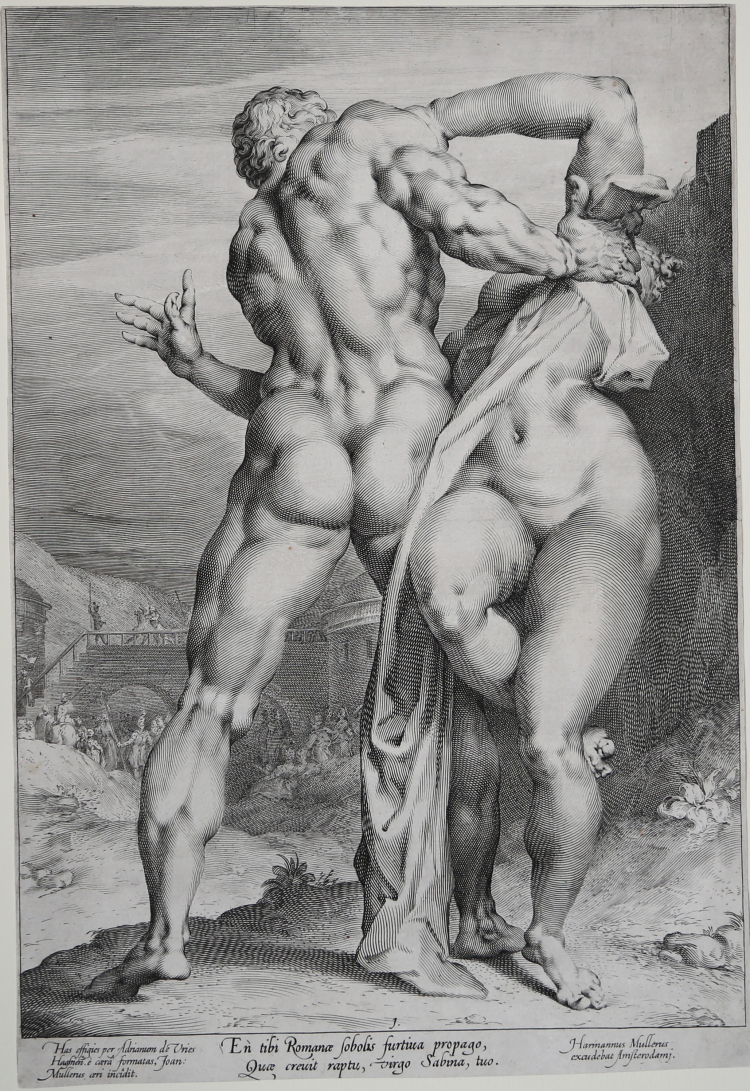



| Reference: | S39265.2 |
| Author | Jan Harmensz MULLER |
| Year: | 1598 |
| Measures: | 285 x 424 mm |


| Reference: | S39265.2 |
| Author | Jan Harmensz MULLER |
| Year: | 1598 |
| Measures: | 285 x 424 mm |
Engraving, 1598 circa, signatures and address in margin below “Has effigies per Adrianus de Vries Hagieň. è cærâ formatas, Joan: Mullerus aeri incidit.” (left); “Harmannus Mullerus excudebat Amsterdamj” (right). Two Latin verses in centre of lower margin: “En tibi Romanae sobolis furtiva prepago/ Quae crevit raptu, virgo Sabina, tuo.” Numbered 1 in centre below, in the image. After Adriaan de Vries.
Example in the third state, of six, before the address “Dancker Danckerts Exc”.
Magnificent example printed on contemporary laid paper, with “shield with Strasbourg lily” (cfr. The New Hollstein – The Muller Dinasty, part II, Appendix, n. 6b, p. 315) thin margins, in excellent condition.
Joan Muller engraved three prints of “The rape of a Sabine woman”, which according to the inscriptions are based on a wax model by Adriaan de Vries. The three prints can be dated to between 1597 and 1600. A remarkable group of proof of these prints are preserved in Amsterdam.
|
TIB, 77; The New Hollstein (The Muller Dinasty, part II), n. 77, p. 208
|
Jan Harmensz MULLER (Amsterdam 1571 - 1628)
|
Dutch engraver, draughtsman and painter. He was the eldest son of Harmen Jansz. Muller (1540–1617), the Amsterdam book printer, engraver and publisher. The family business, called De Vergulde Passer (‘The gilded compasses’), was situated in Warmoesstraat, and Jan Muller worked there for many years. He may have been apprenticed to Hendrik Goltzius in Haarlem. Between 1594 and 1602 he is thought to have gone to Italy, where he stayed in Rome and Naples. He was related by marriage to the Dutch sculptor Adriaen de Vries, who was a pupil of Giambologna. He also maintained contacts with Bartholomeus Spranger and other artists in Prague, which under the rule of Emperor Rudolf II had become a flourishing centre of the arts. In 1602 he made an unsuccessful attempt to mediate on behalf of Rudolf II, who wanted to buy Lucas van Leyden’s Last Judgement. When Harmen Jansz. Muller died, he left the entire stock of his shop, including a number of copperplates, to his bachelor son Jan.
|
|
TIB, 77; The New Hollstein (The Muller Dinasty, part II), n. 77, p. 208
|
Jan Harmensz MULLER (Amsterdam 1571 - 1628)
|
Dutch engraver, draughtsman and painter. He was the eldest son of Harmen Jansz. Muller (1540–1617), the Amsterdam book printer, engraver and publisher. The family business, called De Vergulde Passer (‘The gilded compasses’), was situated in Warmoesstraat, and Jan Muller worked there for many years. He may have been apprenticed to Hendrik Goltzius in Haarlem. Between 1594 and 1602 he is thought to have gone to Italy, where he stayed in Rome and Naples. He was related by marriage to the Dutch sculptor Adriaen de Vries, who was a pupil of Giambologna. He also maintained contacts with Bartholomeus Spranger and other artists in Prague, which under the rule of Emperor Rudolf II had become a flourishing centre of the arts. In 1602 he made an unsuccessful attempt to mediate on behalf of Rudolf II, who wanted to buy Lucas van Leyden’s Last Judgement. When Harmen Jansz. Muller died, he left the entire stock of his shop, including a number of copperplates, to his bachelor son Jan.
|